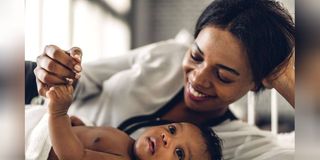Safety concerns as more modern women opt to give birth at home

More women are choosing to deliver in the comfort of their homes, but the medical fraternity is urging caution.
When Vivian Maina learnt that she was pregnant with her second child, she started toying with the idea of a home birth. While it wasn’t a completely foreign concept—she had seen videos on social media—the idea had never crossed her mind until then.
As her pregnancy progressed, the idea gained momentum, and she frequently used her free time researching the process and engaging doulas—professionals who offer support to expectant and new mothers. By the time she was halfway through the pregnancy, Vivian and her partner had decided that they wanted a different birthing experience.
“It was not a question of financial constraints, but I couldn’t get myself back to the hospital. I had a traumatic first birth,” she says.
In March 2019, Vivian, then 25, went into labour with her first-born daughter leading to admission to a hospital. She terms it as an unforgettable experience. “The kind that leaves you with painful memories,” she says.
“A lot was happening around me, in a rush and within a short time. I received little guidance on what to do, or what happens next. In a lot of ways, I felt unseen and uncared for. Granted, I kind of went into that experience without much information on what to expect. I would tell myself, ‘The care providers surely know what to do’, which I think was very naive,” the 30-year-old says.
The birth ended in a caesarean section—a surgical procedure through which the baby is delivered through an incision in the mother’s abdomen and uterus. It is recognised as vital in situations where a vaginal delivery could pose risks to the mother and baby.
“I didn’t have a choice as to whether I wanted the surgery or not. Then I was in an unfamiliar environment, one that brought up many sad memories, partly because of taking care of my late father while he was hospitalised. Each time I think about it, my emotions see-saw: anger, resentment and disgust,” she says.
Before she made the ultimate decision to deliver her baby at home, Vivian researched VBAC (vaginal birth after caesarean).
“I learnt about the risks and acted on what dozens of resources recommended: eat well, exercise and stay consistent.”
Except for her husband, whom she admits was worried even after agreeing to it, other people around her were concerned. The gynaecologists they visited declined to recommend it, saying there were many risks.
“I would tell them, we have done our research, and this is what we have, but none encouraged us to do it. I anchored my support on my husband, midwife, and nanny, who had had two previous successful home births. I delivered a healthy baby in September 2022,” she says.
A research study conducted in 2022 sheds light on the prevalence of, and contributing factors to home deliveries in Eastern Africa. Across 11 countries in the region, the study shows that nearly a fifth of women opt for home births, often facilitated by traditional birth attendants in the absence of healthcare professionals. Unfortunately, many of these deliveries occur under unsanitary conditions, leading to high mortality rates.
According to the United Nations Population Fund, the maternal mortality ratio in Kenya is 355 deaths per 100,000 live births, with approximately 5,000 women and girls dying annually from pregnancy and childbirth complications. Although skilled birth attendance has increased from 62 per cent to 70 per cent in the last seven years, more than 80 per cent of maternal deaths are linked to poor quality of care.
But, Vivian, who is among a growing number of women opting for home births, feels that the numbers don’t tell the whole story.
“I gave birth at home, with a professional midwife at my side and three cars on standby in the unfortunate event of an emergency,” she offers. Home births, she says, are appealing because they happen in a familiar territory. “Plus, we could direct the shots rather than being at the whim of doctors. I was also in my comfortable wear and on my bedroom floor, with my partner by my side,” she reflects.
The marketer is an upcoming doula and argues that “birthing is not a medical procedure. It is a process of bringing life and I believe it should be a beautiful and calm experience”. “However, this perspective is a personal choice and not something I would impose on anyone else,” she says.
For more than two decades, Dr John Ong’ech’s daily routine has involved interacting with expectant or new mothers. He is a chief medical specialist in gynaecology and obstetrics. When expectant women choose to undergo childbirth at home, he says he’s quick to urge caution.
“Delivery in our set-up is a very serious issue, with maternal mortality often attributed to severe bleeding,” he says. Other obstetrics complications can unexpectedly occur when dealing with such births; the baby can go into distress, or the mother has a medical complication such as severe infection, says Dr Ong’ech.
He shared a recent experience. “A woman came to the hospital in utter shock,” he says. “She had experienced extensive bleeding while doing a home delivery and had some tissues retained,” he offers.
The process of labour, the doctor says, is an emotional journey where choices are made between facing trauma and potential fatality.
“The labour ward is a crucial environment for monitoring the birthing process, when something goes wrong in obstetrics, it goes wrong very quickly and the consequences can be loss of life,” he says.
“In the event of an emergency and the patient has to be rushed to the hospital, factoring in our perennial traffic and distances to healthcare facilities, it could take a long time to get there and this simply portends danger to both the mother and the baby,” he says. He adds that the healthcare facility visited during emergencies may not be equipped to promptly address the urgent situation.
Childbirth can be a harrowing experience for some women, with studies indicating that birth-related post-traumatic stress disorder affects approximately 17 per cent of postpartum parents. And a 2019 study by the World Health Organisation indicated that more than a third of women experienced mistreatment during childbirth in health facilities. But Dr Ong’ech says instead of complete abandonment of hospital services, expecting mothers can address trauma root causes, involving partners and doulas in the decision-making process.
“Childbirth is an emotional process and sometimes, one has to choose between trauma or death because of the uncertainties involved in the process. Changing a hospital or having a support system can help an expecting mother through that period,” he says.





